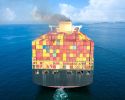Time to pave the way for ammonia

It's about matters of supply and scalability, security, and regulatory issues. But also about public acceptance. According to a new report from Lloyd's Register, the maritime industry needs to embrace and understand the challenges of using ammonia as fuel.
Although the technology for using ammonia as a marine fuel is rapidly advancing, it is dependent on many issues that aren't progressing at the same pace, Lloyd's Register notes in the report "Fule for thought: Ammonia". Gaps in regulations need to be filled, while challenges for the production and delivery of green, zero-emission ammonia must be addressed.
By tackling these issues now, delays can be avoided, and the development of ammonia as fuel can continue at a rapid pace: “For the safe handling and infrastructure, the maritime industry can draw on the extensive experience of transporting ammonia as a cargo throughout the 20th and 21st centuries. There are, however, still concerns around ammonia’s toxicity, crew awareness and training and its overall impact on aquatic, human and environmental health,” the report states.
The toxicity of ammonia and its potential threats to humans are also a mental challenge. Ammonia simply must also gain social acceptance before it can be used as fuel. Additionally, scalability is a challenge: The price of renewable electricity, green hydrogen, and carbon capture will all affect the price of ammonia as a marine fuel. Furthermore, shipping is not the only sector interested in ammonia. According to producers of clean ammonia, there is also expected to be increased demand from agriculture and other sectors for blue and green ammonia, putting pressure on supply.
However, there is hope. As Lighthouse previously reported, a study published by the Global Maritime Forum last autumn showed that the cost gap between ammonia and conventional fuels could be closed by 2030, perhaps as early as 2026. But for this to become a reality, we must "pull several cost-reducing levers simultaneously." This includes everything from designing dual-fuel ships (i.e., the ability for a vessel to run on both conventional fuels and ammonia) and operational efficiency to competitive loan financing arrangements and fuel subsidies.
Research from the Environmental Change Institute (ECI) at the University of Oxford has shown (2023) that while it will cost $2 trillion, it is entirely feasible to transition to a green ammonia fuel supply chain by 2050. Additionally, the industry will become regionalized; green ammonia will primarily be produced near the equator in countries with abundant land and high solar potential and then transported to regional centers for marine fuel demand.
According to Oxford researchers, there will be significant disparities in demand for green ammonia fuel, meaning that a large portion of shipping could transition to fossil-free fuel by targeting the largest ports first. If green ammonia were made available in the top 50 ports worldwide with the highest fuel demand, nearly half of the demand (45.7%) for green ammonia could be met. With the top 100 ports, the corresponding figure is 62 percent. Regionally, disparities could be even greater. For example, in Oceania, North Africa, South Asia, and Southeast Asia, over 60% of fuel demand could be met by focusing on the top 10 regional fuel ports.
-
 Ny studie: Eldrivna pendelbåtar kan effektivisera Stockholms kollektivtrafik
Ny studie: Eldrivna pendelbåtar kan effektivisera Stockholms kollektivtrafik -
 EU: Sjöfartens utsläpp ökar
EU: Sjöfartens utsläpp ökar -
 Sociala relationer påverkar val av bränsle
Sociala relationer påverkar val av bränsle -
 Sjöfartens omställning kräver ”mjukare” påtryckningar
Sjöfartens omställning kräver ”mjukare” påtryckningar -
 Hon hade avtalad tid med Kapten ynkrygg
Hon hade avtalad tid med Kapten ynkrygg -
 Lighthouse omvärldsanalys 2025 – osäkerhet och tullar präglar sjöfarten
Lighthouse omvärldsanalys 2025 – osäkerhet och tullar präglar sjöfarten -
 Se seminariet Shipping in the Marine Environment
Se seminariet Shipping in the Marine Environment -
 Vad betyder egentligen de 90 procenten?
Vad betyder egentligen de 90 procenten? -
 Hålla där...
Hålla där... -
 Ny rapport: Klimatförändringarna ett hot mot de flesta större hamnar i världen
Ny rapport: Klimatförändringarna ett hot mot de flesta större hamnar i världen

